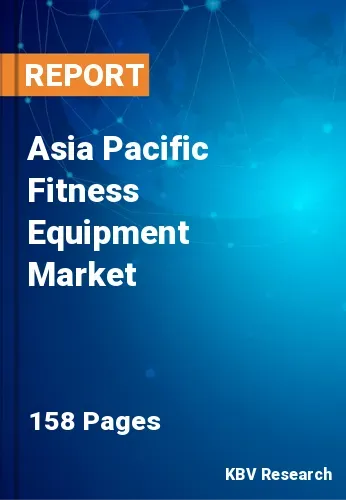The Asia Pacific Fitness Equipment Market would witness market growth of 6.6% CAGR during the forecast period (2023-2030). In the year 2021, the Asia Pacific market's volume surged to 2,287.1 thousand units, showcasing a growth of 6.8% (2019-2022).
Strength training equipment is designed to build muscle strength and endurance. They are essential for those aiming to increase muscle mass, tone the body, and enhance overall physical performance. Innovations in strength training equipment have led to more ergonomic designs, variable resistance options, and digital assistance for form and technique. In the healthcare sector, this equipment is increasingly used for rehabilitation purposes. Physical therapists and medical professionals utilize equipment like exercise bikes, resistance bands, and balance boards to aid patients in recovering from injuries or surgeries. These specialized fitness tools help individuals regain mobility, strength, and function while reducing the risk of further injuries.
Moreover, athletes and sports enthusiasts rely on sports-specific training equipment to improve their performance in a particular discipline. This can range from agility training equipment for soccer players to specialized resistance machines for weightlifters. Developing sports-specific fitness equipment has become an essential aspect of modern sports training programs. The fitness equipment market is expanding beyond physical fitness to encompass holistic health and wellness. Products that promote mental well-being, stress relief, and relaxation are gaining popularity. This includes equipment for yoga, meditation, and mindfulness practices, as well as massage and recovery tools. The focus on mental and emotional health is becoming integral to the market.
The region has seen a significant increase in disposable income for many people, leading to changes in lifestyle. As income rises, people often have more access to processed and fast foods, which can contribute to unhealthy eating habits. Indian Gross Domestic Product (GDP) has steadily increased, increasing incomes for individuals and households. As per the Indian Ministry of Statistics & Programme Implementation, the predicted Gross National Disposable Income (GNDI) for the years 2021–22 was $236.07 billion at current prices, whereas the estimate for the years 2020–21 was $201.15 billion. This difference represents a growth of 17.4 percent for the years 2021–22 as opposed to a decline of 1.6 percent in the years 2020–21. Thus, with the growing obesity numbers and disposable income in many nations in Asia Pacific, the demand in the regional market will also increase.
The China market dominated the Asia Pacific Fitness Equipment Market by Country in 2022 and would continue to be a dominant market till 2030; thereby, achieving a market value of $1,458.7 million by 2030. The Japan market is registering a CAGR of 5.9% during (2023 - 2030). Additionally, The India market would showcase a CAGR of 7.2% during (2023 - 2030).
Based on Distribution Channel, the market is segmented into Offline, and Online. Based on Type, the market is segmented into Cardiovascular Training Equipment (Treadmills, Stationary Cycles, and Others), Strength Training Equipment, and Others. Based on End-user, the market is segmented into Home Consumers, Fitness Centers/Gyms, and Others. Based on countries, the market is segmented into China, Japan, India, South Korea, Singapore, Malaysia, and Rest of Asia Pacific.
Free Valuable Insights: The Global Fitness Equipment Market is Predict to reach $18.8 Billion by 2030, at a CAGR of 5.8%
The market research report covers the analysis of key stake holders of the market. Key companies profiled in the report include Suunto Oy (Amer Sports Corporation), Nautilus, Inc., Brunswick Corporation, Johnson Health Tech Co., Ltd., True Image Interactive, Inc., Life Fitness (Cybex International, Inc.), Impulse (Qingdao) Health Tech Ltd. Co., Icon Health & Fitness, Inc. (IHF Holdings Inc.), Torque Fitness LLC., Core Health & Fitness, LLC
By Distribution Channel (Volume, Thousand Units, USD Billion, 2019-2030)
By Type (Volume, Thousand Units, USD Billion, 2019-2030)
By End-user (Volume, Thousand Units, USD Billion, 2019-2030)
By Country (Volume, Kilo Tonnes, USD Billion/Million, 2019-2030)

Our team of dedicated experts can provide you with attractive expansion opportunities for your business.

